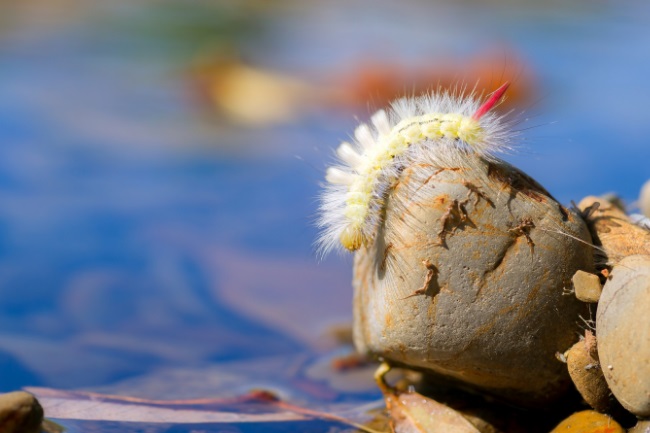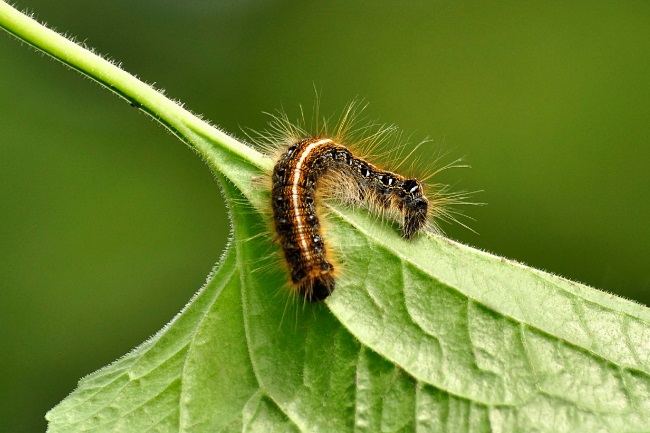Most caterpillars are safe to handle, but some have irritating hairs or even dangerous toxins, which can causes rashes or even more severe injury. Gloves should be used, and the skin protected.
Contents
The good, the bad and the ugly

We tend to think of caterpillars as entirely harmless; sweet little insects busy eating their weight in leaves. Yet, not all caterpillars are altogether defenceless, and some will be more than happy to register their displeasure at being handled.
| Caterpillar Species | Defense Mechanism |
|---|---|
| Io Moth (Automeris io) | Stinging spines or hairs called urticating setae |
| Saddleback Caterpillar | Stinging spines or hairs called urticating setae |
| Puss Caterpillar | Venomous spines or hairs |
| Hickory Tussock Moth | Venomous spines or hairs |
| Lonomia Caterpillar | Venomous spines or hairs |
From a slight itch to a nasty sting to a life-threatening poison, there’s more than a bit of danger in handling species that you don’t recognise.
Also read: What do Caterpillars Eat? (Vegan vs. Carnivore Caterpillars)
A nasty itch

Many species of caterpillars have evolved to be covered in hairs, either densely enough that they look like walking wigs, or sparsely so as to be barely noticeable. There are many advantages to being a hairy caterpillar. For one thing, it makes you look more intimidating, increasing your overall size and making you seem potentially dangerous to handle.
Dense fuzz also makes these species less appealing to eat, as they are more difficult to swallow. A significant threat to many species are parasites, such as wasps, which lay their eggs inside the caterpillar, leading to death by being eaten from the inside out. A thick coating of spikey hairs can make it more difficult for the parasite to complete this nasty process.
Despite their scary appearance, not all of these caterpillars will cause you any harm. Yet if you don’t know your friendly fluff from your not-so-friendly fluff, it’s worth avoiding all. The oak processionary moth has urticating (irritating) hairs, which can cause an unpleasant rash if handled. Sometimes these can even be blown away in the wind and irritate those nearby. It is also thought that the hairs can persist in the environment for up to a year.
To make the best use of their defence mechanism, caterpillars can writhe or actively push their hairs against the skin of an attacker; some may even shed their hairs. However, despite all this, some birds have found a way around the problem by brushing the caterpillar against the ground or the bark of a tree to dislodge the irritating hairs.
Also read: What Eats Caterpillars? (A List of its Enemies)
A nasty sting

Many caterpillar species have developed the ability to produce toxins, which are administered through hollow spines on their body. These are generally meant to put predators off eating the little insects, but they, unfortunately, can’t differentiate between an inquisitive hand and a snapping beak.
The gum leaf skeletonizer, famous for wearing a tower of its own moulted heads as a hat, is one such species that can give you a nasty sting and a rash if handled.
Many of the slug moth caterpillars carry stings to them. The spiny oak slug is a beautiful green and orange caterpillar with many spines. Luckily this attractive caterpillar’s sting isn’t too painful, unlike its cousin, the southern flannel moth, which looks like a walking wig and feels like blunt-force trauma.
A deadly sting

Very few caterpillars can kill humans; however, many Lonomia species have nasty toxins that can cause internal bleeding and kidney failure. The giant silkworm larvae in South America is the most famous of these.
This has a series of sharp spines down its body, which will inject a toxin into the skin if pressed into. Caterpillars don’t go out of their way to sting humans, and the damage tends to take place through accidental leaning on these insects while they go about their business.
| Risk | Explanation |
|---|---|
| Allergic Reactions | Some people may develop allergic reactions to caterpillar hairs |
| Skin Irritation | Contact with certain caterpillars can cause skin irritation |
| Stinging or Venomous Caterpillars | Caterpillars with stinging hairs or venomous spines can cause pain or injury |
| Health Hazards | Certain caterpillars may carry pathogens or bacteria |
Other nasty tricks
There’s more to caterpillar defence than spines and stings. Most utilise poisons that need to be ingested by a predator. Unless you’re planning to eat the caterpillars you collect, this shouldn’t be a problem for you. However, the variable oakleaf caterpillar moth has the astounding ability to spit acid at its attackers, burning the skin and causing irritation.
Also read: Why are Young Caterpillars Left to Look after Themselves?
Should we be afraid of caterpillars?
While these irritating and sometimes deadly caterpillars might make it seem like all of these insects are to be feared and avoided, the fact is that most of them are entirely harmless.
Even those that carry spines, such as the peacock butterfly caterpillar, often only have them to pretend they are dangerous and scary. And those toxic few are generally just heading out to work, busy finding enough to eat to get good and fat and grow up to be a beautiful butterfly or a marvellous moth.
If anything, it’s us they are scared off, big bumbling humans, likely to step on them or accidentally squash them.
Ideally, you will leave these caterpillars to get on with their day, and they will let you get on with yours. But if you do have to interact, remember to wear gloves and protect your skin. If you do accidentally come into contact, go to your doctor if you get a reaction. Most reactions will be uncomfortable rather than deadly, but it’s worth noting which many-legged insect it was that ruined your day.

